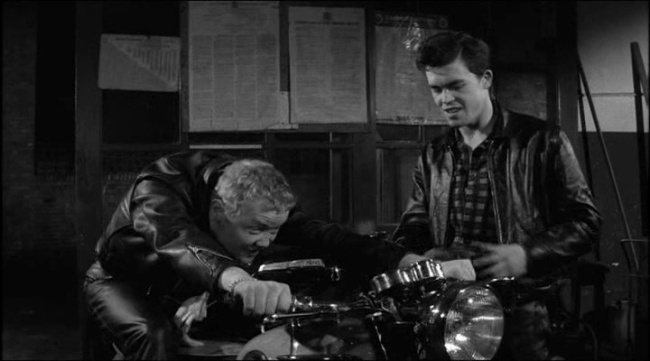
It's hard enough breaking from the flow of tradition and social pressure, it's harder when you have something in your heart you never thought to look for. 1964's The Leather Boys is based on a novel that more directly explores the difficulties a young gay man faced in the 1960s but the film is nicely shot, despite coming from Superman IV director Sidney J. Furie, with naturalistic performances that spend a great deal of time dwelling on the tensions a young gay man would have faced.
The beginning of the film is filled with energy--the hyperactive biker teens at the cafe turns into the energetic, mad dash wedding of Reggie (Colin Campbell) and Dot (Rita Tushingham).

These two kids who spend most of their time wearing leather jackets and talking motorcycles are suddenly on a well worn, rapid treadmill. Parents who a couple scenes earlier disapproved of the pair are now cooing over cutting the wedding cake.

Something happens when they have sex on their honeymoon. The film doesn't say exactly what but Dot is clearly disappointed and Reggie is annoyed. Still, it seems perfectly innocent to her to start spending more time at the beauty salon and chatting with tourists than she does with Reggie. The pattern settles in when they get home. When they're apart, Reggie finds a million things to complain about regarding her, when they're together, they fight. Gradually he finds he prefers hanging out with his fellow biker, Pete (Dudley Sutton).

The film does directly broach the subject of homosexuality and it's pretty clear that Pete is gay and comfortable with it. It also doesn't demonise homosexuality but it does, in the end, ultimately back away from its own thematic momentum in a way that suggests the film was forced to go a certain way by production code or studio. But like Alfred Hitchcock was still happy with the 90% of his film Suspicion before the studio enforced ending, The Leather Boys maintains a nice artistic existence for most of its run time. Colin Campbell gives a subtle performance as the young man who for the most part doesn't seem to know what his own problem is before it becomes something he's afraid to acknowledge and explore.

The sense of social momentum is well conveyed and it's illuminating to note the rebel biker gang of the Wild One mode is just as rigidly traditional in some ways as their parents.
Footage of the film was later used for The Smiths' "Girlfriend in a Coma" music video which takes on a new significance when one knows the film's subtext.

No comments:
Post a Comment